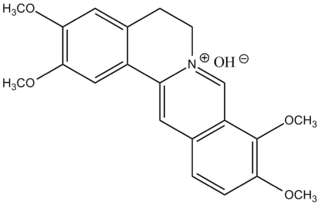
Noscapine is a benzylisoquinoline alkaloid, of the phthalideisoquinoline structural subgroup, which has been isolated from numerous species of the family Papaveraceae. It lacks significant hypnotic, euphoric, or analgesic effects affording it with very low addictive potential. This agent is primarily used for its antitussive (cough-suppressing) effects.
Neuraminidase inhibitors (NAIs) are a class of drugs which block the neuraminidase enzyme. They are a commonly used antiviral drug type against influenza. Viral neuraminidases are essential for influenza reproduction, facilitating viral budding from the host cell. Oseltamivir (Tamiflu), zanamivir (Relenza), laninamivir (Inavir), and peramivir belong to this class. Unlike the M2 inhibitors, which work only against the influenza A virus, NAIs act against both influenza A and influenza B.

Scoulerine, also known as discretamine and aequaline, is a benzylisoquinoline alkaloid (BIA) that is derived directly from (S)-reticuline through the action of berberine bridge enzyme. It is a precursor of other BIAs, notably berberine, noscapine, (S)-tetrahydropalmatine, and (S)-stylopine, as well as the alkaloids protopine, and sanguinarine. It is found in many plants, including opium poppy, Croton flavens, and certain plants in the genus Erythrina.

Berberine is a quaternary ammonium salt from the protoberberine group of benzylisoquinoline alkaloids
In enzymology, a (S)-scoulerine 9-O-methyltransferase is an enzyme that catalyzes the chemical reaction
(S)-Tetrahydroberberine oxidase is an enzyme that catalyzes the final transformation in the biosynthesis of berberine, a quaternary benzylisoquinoline alkaloid of the protoberberine structural subgroup. This reaction pathway catalyzes the four-electron oxidation of (S)-tetrahydroberberine in the presence of oxygen to produce berberine and hydrogen peroxide as products.
In enzymology, a reticuline oxidase (EC 1.21.3.3) is an enzyme that catalyzes the chemical reaction
In enzymology, a (S)-canadine synthase (EC 1.14.21.5) is an enzyme that catalyzes the chemical reaction
The enzyme (S)-norcoclaurine synthase (EC 4.2.1.78) catalyzes the chemical reaction

Higenamine (norcoclaurine) is a chemical compound found in a variety of plants including Nandina domestica (fruit), Aconitum carmichaelii (root), Asarum heterotropioides, Galium divaricatum, Annona squamosa, and Nelumbo nucifera.

Substitution of the heterocycle isoquinoline at the C1 position by a benzyl group provides 1‑benzylisoquinoline, the most widely examined of the numerous benzylisoquinoline structural isomers. The 1-benzylisoquinoline moiety can be identified within numerous compounds of pharmaceutical interest, such as moxaverine; but most notably it is found within the structures of a wide variety of plant natural products, collectively referred to as benzylisoquinoline alkaloids. This class is exemplified in part by the following compounds: papaverine, noscapine, codeine, morphine, apomorphine, berberine, tubocurarine.

Protopine is an alkaloid occurring in opium poppy, Corydalis tubers and other plants of the family papaveraceae, like Fumaria officinalis. Protopine is metabolically derived from the benzylisoquinoline alkaloid (S)-Reticuline through a progressive series of five enzymatic transformations: 1) berberine bridge enzyme to (S)-Scoulerine; 2) (S)-cheilanthifoline synthase/CYP719A25 to (S)-Cheilanthifoline; 3) (S)-stylopine synthase/CYP719A20 to (S)-Stylopine; 4) (S)-tetrahydroprotoberberine N-methyltransferase to (S)-cis-N-Methylstylopine; and ultimately, 5) N-methylstylopine hydroxylase to protopine.

Huáng bǎi, huáng bó or huáng bò is one of the fifty fundamental herbs of traditional Chinese medicine. Known also as Cortex Phellodendri, it is the bark of one of two species of Phellodendron tree: Phellodendron amurense or Phellodendron chinense.

Palmatine is a protoberberine alkaloid found in several plants including Phellodendron amurense, Coptis Chinensis and Corydalis yanhusuo, Tinospora cordifolia, Tinospora sagittata, Phellodendron amurense, Stephania yunnanensis.

Miquelianin is a flavonol glucuronide, a type of phenolic compound present in wine, in species of St John's wort, like Hypericum hirsutum, in Nelumbo nucifera or in green beans.

(S)-Cheilanthifoline is a benzylisoquinoline alkaloid (BIA) which has been isolated from Corydalis dubia and Argemone mexicana. (S)-Cheilanthifoline is metabolically derived from (S)-reticuline, a pivotal intermediate in the biosynthesis of numerous BIAs. (S)-Cheilanthifoline is the immediate precursor of the BIA (S)-stylopine ((S)-stylopine synthase/CYP719A20), which is the precursor for the alkaloids protopine and sanguinarine.

(S)-Magnoflorine is a quaternary benzylisoquinoline alkaloid (BIA) of the aporphine structural subgroup which has been isolated from various species of the family Menispermaceae, such as Pachygone ovata,Sinomenium acutum, and Cissampelos pareira.

Berberine bridge enzyme-like form a subgroup of the superfamily of FAD-linked oxidases, structurally characterized by a typical fold observed initially for vanillyl-alcohol oxidase (VAO). This proteins are part of a multigene family (PF08031) that can be found in plants, fungi and bacteria.

4-Hydroxyphenylacetaldehyde, also known as p-hydroxyphenylacetaldehyde, is a natural product with the formula HOC6H4CH2CHO. It is a derivative of phenylacetaldehyde and occurs as a white solid at room temperature.

Aporphine alkaloids are naturally occurring chemical compounds from the group of alkaloids. After the benzylisoquinoline alkaloids they are the second largest group of isoquinoline alkaloids.














